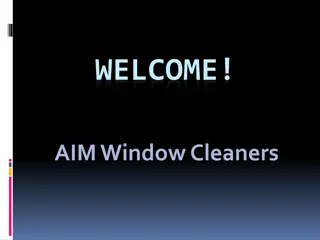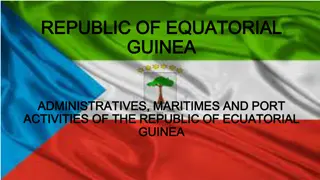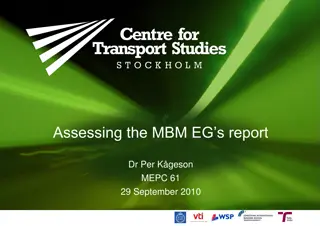European Maritime Single Window environment
Explore the European Maritime Single Window environment with key definitions, established platforms, and past regulations aiming to simplify and harmonize maritime reporting formalities in the EU. Understand port calls, declarants, reporting obligations, and the purpose behind this regulatory framework.
Download Presentation

Please find below an Image/Link to download the presentation.
The content on the website is provided AS IS for your information and personal use only. It may not be sold, licensed, or shared on other websites without obtaining consent from the author.If you encounter any issues during the download, it is possible that the publisher has removed the file from their server.
You are allowed to download the files provided on this website for personal or commercial use, subject to the condition that they are used lawfully. All files are the property of their respective owners.
The content on the website is provided AS IS for your information and personal use only. It may not be sold, licensed, or shared on other websites without obtaining consent from the author.
E N D
Presentation Transcript
European Maritime Single Window environment Overview and introduction
Key definitions (6) port call means the arrival of a ship at, the stay of a ship in, and the departure from a maritime port in a Member State; (11) declarant means any natural or legal person who is subject to reporting obligations or any duly authorised natural or legal person acting on that person's behalf within the scope of the relevant reporting obligation; (5) reporting obligation means the information required by the Union and international legal acts listed in the Annex, as well as national legislation and requirements referred to in the Annex which has to be provided in connection with a port call; (7) data element means the smallest unit of information which has a unique definition and precise technical characteristics such as format, length and character type;
Key definitions (3) established and operated technical platform for receiving, exchanging and forwarding electronically information to fulfil reporting obligations, which includes commonly defined management of access rights, a harmonised reporting interface module and a graphical user interface for communication with declarants, as well as links with the relevant authorities systems and databases at national and at Union level, which enables messages or acknowledgments covering the widest range of decisions taken by all of the participating relevant authorities to be communicated to declarants, and which could also allow, where applicable, for the connection with other reporting means; 'maritime National Single Window means a nationally
Past -> Directive 2010/65/EU -> Regulation 2019/1239/EU To facilitate maritime transport and further reduce administrative burden for shippers, to improve the competitiveness and efficiency of the sector and improve the working conditions for ship masters, through further simplification and harmonisation of information transmission procedures
Evaluation of the EU Directive on Reporting Formalities The Directive 2010/65/EU on Reporting Formalities adopted in 2010 has failed to reduce sufficiently administrative burden due to lack of harmonisation between the EU Member States. Total of 2.5 mi hours could be saved annually with more efficient reporting procedures. Problems: Diverse interfaces: All National Single Windows have different interfaces, data formats and procedures Diverse reporting requirements: The Directive covers only 14 international and EU formalities Data requirements not harmonised: data not efficiently re- used = reporting duplication
EMSWe subject matter and scope This Regulation establishes a framework for a technologically neutral and interoperable European Maritime Single Window environment ( EMSWe ) with harmonised interfaces, in order to facilitate the electronic transmission of information in relation to reporting obligations for ships arriving at, staying in and departing from a Union port.
Provisions of EMSWe A decentralised network of Maritime National Single Windows with: A harmonised common data set Comprehensive reporting all reporting formalities, including customs and national and local reporting Harmonised interfaces for manual reporting and system-to-system with harmonised internet addresses A common user registry and access management system Common databases for ship identification, locations codes and information on dangerous and polluting goods Publication of arrival and departure times of ships calling in EU ports
Involved parties around EMSWe Declarant Any natural or legal person who is subject to reporting obligations or any duly authorised natural or legal person acting on that person s behalf within the limits of the relevant reporting obligation Data service providers Who provides ICT service for the declarant in order to connect to the interfaces and exchange information with the MNSWs. MS s competent national authorities and customs Authorities that require data to be submitted when ships makes a port call in EU port Authorities responsible for customs formalities Industry, Member States, Commission and EMSA Parties involved in establishing the EMSWe
Main components of EMSWe Maritime National Single Window Graphical User Interface Reporting Interface Module* Common databases EMSWe ship database* Common location database* Common Hazmat Database* Common Ship Sanitation Database* User registry and access management system* Common Addressing Service*
EMSWe architecture components Member State responsibilities deriving from the Regulation MNSW - Maritime National Single Window (Article 5(1)) GUI Graphical User Interface of the MNSW, adherence to the common functionalities (Article 5 (3.a)) Compatibility of the MNSW with the harmonised reporting module(Article 5 (3.a)) Connections with the relevant systems of the competent authorities(Article 5(3.c), 4)
European Commission DG MOVE Unit D.1 Maritime Transport and Logistics move-emswe@eu.europa.eu martins.zieds@eu.europa.eu



























